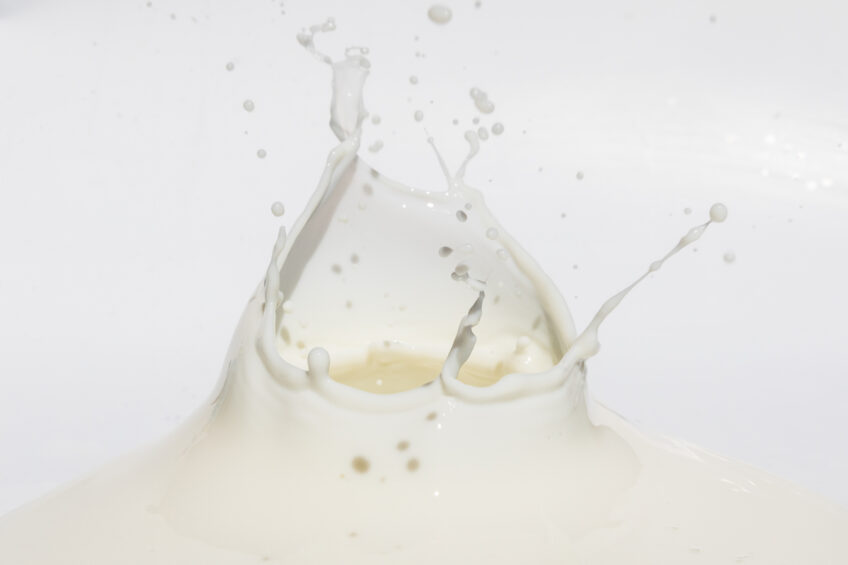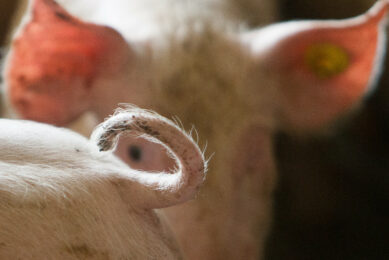Dairy lipids can narrow the piglet weaning dip

In piglet nutrition, dietary fat obviously provides energy, but it is also essential for tissue growth, cardiovascular health and the development of the enteric nervous system and the immune system. Extensive research has shown how a lipid-containing component of cow milk benefits the development and health of newborn infants; new perspectives loom for piglets too.
“Milk fat globule membrane” (MFGM) is the full name of the lipid-containing component. As its name suggests, it is a membrane that surrounds the lipid core of milk fat globules with 3 layers of various lipid types. It’s studded with proteins (over 500 types, mainly glycoproteins that resist digestion) and carbohydrates (mainly glycoproteins or glycolipids).
Some of these specific MFGM components are bioactive, notes Dr Evi Croes, R&D manager at Nukamel. This animal nutrition company has been working on MFGM for several years now. The components also provide synergistic benefits in their combinations and because of their structural organisation. “The lipid-lipid and lipid-protein interactions within the MFGM structure afford these molecules a degree of persistence in the gastrointestinal lumen,” she explains. “Because of this, they are conveyed to the large intestine where they perform specific roles in strengthening immune response, promoting intestinal development and providing direct antimicrobial effects.”
Reducing number of fever days
In human infants, consumption of MFGM-enriched formula has been shown, for example, to reduce the number of days with fever and help prevent infections through actions such as prevention of pathogen adhesion to gut epithelium.
“Similarly, studies on rodent and piglet models have shown benefits of MFGM on infection, inflammation, brain composition and gut barrier integrity, as well as intestinal development,” says Dr Croes. “In rat pups, MFGM-supplemented diets fed from day 5 resulted in a better restoration of the intestinal villus and crypt architecture and improved expression of tight junction proteins, which help prevent pathogen entry. Inflammatory response with an MFGM-rich diet was significantly lower, and serum levels of different cytokines (damaging immune system molecules) were decreased, signifying reduced stress on the gut barrier.”
Effects in young piglets
In young piglets, MFGM showed similar effects: accelerated maturation of the intestinal immune system that was closer to that observed in mother-fed piglets, increased mucosal growth and enhanced protection against the invasion of pathogens. There were also higher plasma IgG antibody levels and active colonisation of the gut with short-chain fatty-acid-producing bacteria with dietary MFGM.
Although these first studies were not numerous, they caught the attention of Dr Croes and her colleagues. “As we specialise in young livestock animal nutrition, we are always keeping up with infant nutrition research and research on dairy ingredients,” she explains. “We looked into where we could get MFGM raw materials. MFGM-enriched dairy ingredients can be produced commercially from either whey or cream concentrates and they only became readily available in the last 5 years or so as interest in using MFGM in infant formula increased. We analysed the different raw materials and sought those treated only with low heat to maintain as much of the biological value as possible. In 2019 we did our first trials with broiler chicks and calves, testing different formulations and percentages of MFGM.”
Large litters
Litter sizes have been increasing for decades due to breeding for this trait, nutrition improvements and other factors. Dr Michael Langemeier at Purdue University has recently analysed US Department of Agriculture data. He notes, “Pigs per litter has increased at a rate of 0.104 per year since 1993.”
With these large litter situations comes the need to supplement the piglets’ nutritional intake to protect their health and prepare them for weaning. Producers are looking for milk replacers that prevent digestive issues and respiratory infections in order to achieve good growth rates and avoid veterinary services and the use of antibiotics.
Nukamel has developed 2 products for piglets, a milk replacer and a fat navigator, containing MFGM. The company launched them in late 2022. The milk replacers for piglets are marketed as Piglait (in 2 formulations) and the fat navigator as Volamel Compass, which supports not only fat digestion, but also particularly fat metabolism in piglets immediately after weaning.
Piglet study in Belgium
The latter approach was put to the test before commercial launch, in a piglet study in collaboration with Belgian trial farm Innsolpig. Around 280 piglets from a DanBred sow and Belgian Piétrain boar weaned at 3 weeks of age were given a barley-wheat-soy diet in weaner and starter formulations for 7 weeks. The early-weaned piglets that received Volamel Compass (500 ppm added to the diets) had a feed conversion ratio of 1.42 compared to 1.48 achieved by the control pigs. Body weights were also improved at the end of the trial, with treated pigs weighing on average 23.2 kg compared to 21.7 kg with the control diet.
In another study of 11 weeks, piglets in litters of 12–14 that were given Piglait compared to other milk replacers had a feed intake 2.2 kg higher (dry matter intake/litter). Their weights were 0.5 kg higher; there was more uniformity and less diarrhoea as well.
We know that investing in the young animal always pays off later on
Cost–benefit analysis
In terms of return on investment, savings are not easy to quantify exactly. Every swine operation is different, Dr Croes notes, and obviously the quality of piglet and sow management implemented (hopefully by well-trained workers) plays a key role in excellent piglet performance, no matter what milk replacers or additives are provided in the diet. “We do know that investing in the young animal always pays off later on,” Dr Croes says. “Piglets that are weaned 0.5 kg heavier could easily be about 1 kg heavier at the end of the nursery phase. This added effect on gain is multiplied by 4 in the fattening period. So, piglets end up with 4 kg more weight at slaughter or can go to the slaughterhouse 4 to 8 days earlier .”
Dr Croes also notes that MFGM given as a supplement to piglets from birth has been shown to provide positive long-term effects in the adult pig immune system. “There is one study where, compared to the control diet animals that were fed vegetable oils, pigs that received dairy lipids in infancy showed decreased pro-inflammatory cytokine secretions in response to a lipopolysaccharide challenge,” she says, “confirming the beneficial impact of dairy lipids on the intestinal immune system.”
MFGM: a good preparation for smooth weaning
The company’s research shows higher dry matter intake and increased growth rates with MFGM fed to piglets and, as mentioned, many studies done by independent researchers have demonstrated that MFGM provides a good preparation of the digestive and immune systems for smooth weaning. Dr Croes says, “With our products, producers can expect to see reduced ‘weaning dip’, reduced or no incidence of diarrhoea and reduced need for post-weaning antibiotics and zinc oxide. We also know that with our products, producers can reduce additives that they would otherwise be putting in the diet to promote health and robust performance. Producers are not always keenly aware of how much of these additives they are putting in their diets and the total cost of that. And of course, as mentioned before, good management counts.”











